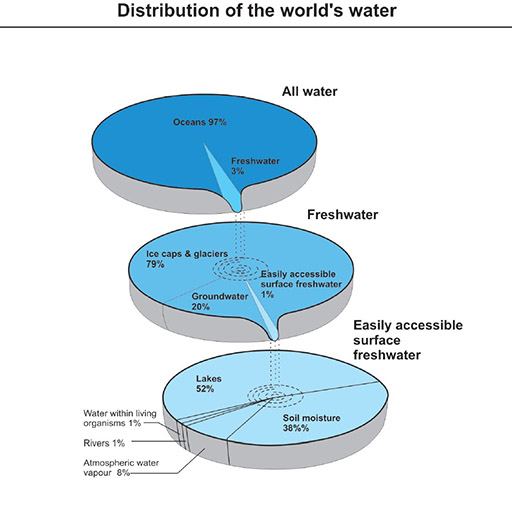Resource 2: Water issues
![]() Background information / subject knowledge for teacher
Background information / subject knowledge for teacher

The following text is adapted from ‘The looming national dilemma of water crisis in peri-urban areas in Ghana’ by Dr Kwasi Nsiah-Gyabaah. Details of the project can be found at: and can be found at: http://www.gwcl.com.gh/pgs/kumasi.php.
The water crisis
Although Ghana has abundant water resources, the country experiences chronic water shortages due to poor distribution of rainfall, prolonged drought and poor management of water resources. Throughout the country, destruction of watersheds, contamination, and overexploitation of underground water resources pose a serious challenge to agriculture, industrial development and the health of people in the urban and peri-urban areas.
Several studies show that exploited aquifers in the urban and peri-urban areas are already showing increasing presence of iron and nitrate pollution (DFID, 2000), and drinking water sources are also polluted through inappropriate disposal of domestic wastes especially human excreta. The three major problems affecting water resources in the urban areas with large population concentrations include:
- overexploitation;
- cutting down of trees in the watershed;
- misuse of water and wastage through bust pipes;
- pollution through agriculture and domestic waste disposal systems.
The survey revealed that the city depended on the surrounding region or peri-urban area to act as sink and disposal sites for domestic and industrial wastes. The peri-urban areas were not only affected by air pollution but also suffered from unplanned disposal of polluted water and illegal dumping of other wastes, especially night soil generated in the city. Water pollution negatively affected agricultural productivity and compromised the safety of fresh farm produce.
With rapid increase in the number of vehicles, vehicle repair shops and car washing bays, oil and water pollution was assuming an important significance as an environmental problem in the peri-urban area.
In 1977, a research project that was carried out to examine the effects of the growth of Kumasi on natural resources management observed that the main water supply problems related to:
- depletion of water resources through wanton destruction of trees at watersheds;
- contamination from hospital waste;
- degradation of watersheds through bush fires, housing encroachment, sand winning etc.;
- bacteriological contamination of rivers, streams and aquifers through inappropriate waste disposal systems;
- urban and rural run-off, soil erosion and siltation of water resources;
- pollution of rivers and streams by nitrates from fertilisers and traditional organic waste was increasingly causing serious environmental and health problems in the peri-urban area of Kumasi;
- the degradation of watersheds caused by human activities, especially housing development and agriculture, was becoming intensive, water resources were being altered, and little attention was given to conservation practices.
The problems related to water quality were:
- high turbidity levels and sediments within important basins such as the Sisa and Oda;
- increasing water resources pollution caused mainly by domestic wastes, industries, abattoirs, garages;
- pollution caused by increasing use of chemical fertilisers and toxic substances, especially in horticultural crop production for the urban market. Iron and arsenic pollution and heavy metal and other dangerous substances were threatening aquatic and human life.
In Kumasi, the Barekese Dam, a major source of water supply to the Kumasi metropolis, the sub-urban and rural areas, is being threatened by villagers' cutting trees and farming in its catchment areas. The trees that protect and feed the system are being destroyed. In Accra, some quarrying, negative agricultural and fishing practices, illegal physical development, and agricultural activities have put pressure on the Densu river, which feeds the Weija Dam, the source of water for the western area of Accra metropolis. Important streams that feed the Densu river have also been polluted and destroyed by these negative acts.
Bushfires, in addition to agriculture, are the major driving forces behind watershed degradation. The activities of vegetable crop farmers have been more devastating to water resources. Some farmers have been pumping water from the river to their farms, contributing to the dying up the river. According to available statistics, daily water production in Abesim had reduced from the original 1. 6 million gallons to 534,000 gallons a day (Ghanaian Times, Tuesday, 20 February 2001, p. 2). The situation has brought acute water shortages to Sunyani, Acherensua, Abesim and other areas. At Sunyani, some people have been walking long distances to get water, some from polluted sources.
The time has come for government officials and the relevant institutions to stop talking about the destruction of our water bodies and to take direct and positive actions against those who destroy such important natural resources.

Resource 1: Plant handout



